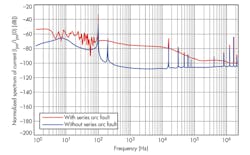With the increased deployment of high-power dc systems such as those used in electric vehicles, wind turbines, photovoltaic plants, and other large-scale energy harvesters, there is a growing concern over arcs forming across insulators that do not self-extinguish. Damage caused by high-power arcs can be extensive as well as extremely dangerous. These issues are driving technology for sensing the presence of arc formation in high-power systems.
Background
Arc formation was first observed in the early 1800s by both Sir Humphry Davy, who is generally acknowledged for the discovery, and a Russian experimental physicist named Vasilii Vladimirovich Petrov, whose work predated Davy’s. It has been a focus of study since that time and applied in a wide range of industrial applications such as welding, machining, metallurgy, chemistry, and lighting.
Related Articles
- The Use And Misuse Of Circuit Protection Devices
- Design FAQs: Semiconductor Circuit Protection Devices
- Design FAQs: How To Use Transient Protection Devices
However, arcing can have an unintentional dark side in high-power systems. It can vaporize conductors, ablate surfaces, explode insulators, start fires, and cause severe injury. This is due to the high power present in the system and the phenomenon related to the formation of an arc.
Arcs are formed when an insulator, typically a gas such as air, breaks down under a strong electric field, allowing the conduction of electric current via plasma formation. Interestingly, the resistance of the current path through the arc produces heat, which ionizes more gas, resulting in an improved conduction path and reducing the voltage between the ends of the arc. This is also known as a negative resistance, which lets the current increase unbounded limited only by the source of the current. This phenomenon in part is what makes arcing so dangerous.
This file type includes high resolution graphics and schematics when applicable.
Arc Faults
The plasma that forms within the arc is extremely hot and can exceed 35,000°F (19,400°C). This is hot enough to vaporize metal, leading to what is known as an arc blast. The explosive nature is the result of rapidly expanding plasma and molten metal as well as high levels of radiant emissions ranging from the far infrared to ultraviolet. Nearby objects (including people) will absorb this radiant energy or be struck by the rapidly expanding shockwave, which can result in severe damage or injury.
There are two types of arc faults: parallel and series. Parallel arc faults occur in parallel with the load (or to ground for most dc systems). This looks like an increase in load current and is the most dangerous since nothing but the source is limiting the current flow. A series arc fault occurs when the conductor to the load breaks or is opened in some way (as in a switch). The load limits the current in this type of arc fault, but it also can be dangerous due to plasma formation.
Circuit breakers and fuses often are used to prevent catastrophic damage from these types of events, but they are slow to operate due to the nature of their design. Other methods can be used to quickly detect an arc fault and shut down equipment to prevent damage. Systems can implement optical detection where photodiodes are used to pick up the emission spectrum of an arc fault. Another method is to use acoustic detection, much like listening for thunder. Both of these methods suffer from various implementation issues and can be extremely complex or, in some cases, ineffective.
Optical methods rely on the placement of photodiodes near potential arc locations such as near insulators. This can add significant complexity to a system where there could be a large number of potential locations arcs could form. Some manufacturers of optical arc detection systems use cables that include optical waveguides built into the insulation (which is transparent) to carry the optical arc signature back to a detector that can process the signature and interrupt the power flow if an arc is detected.
Acoustic detection must wait for the arc signature wave front to reach the sensor that only travels at the speed of sound, which depends on the medium. Detectors often utilize piezoelectric transducers connected directly to bus bars to pick up the shockwave’s ultrasonic signature. This can have significant safety issues, and isolating the sensors can be problematic.
Detecting RF Arc Signatures
Another method of detection relies on the electrical noise induced into the transmission line when an arc forms. Arcing has significant broadband energy with a notable increase from dc to roughly 1 MHz (see the figure). Since modern ac inverters often also have unintended conducted and emitted radiation in this spectrum (50 kHz to 100 kHz) as well as other manmade and natural phenomena such as lightning, a significant amount of signal processing is needed to differentiate an arc occurring in the system from some external event that is unrelated.
This method relies on coupling through a transformer or coil to the series conductor, which provides a significant advantage in simplicity. As dc current flows through the conductor, the noise caused by arcing modulates the current, providing a way to sense the arcing event anywhere along the transmission line. A problem with this method is that the signature dissipates over distance, so monitoring for arcing far from the sensor is an issue.
Systems that use this technique must look for an increase in energy across a section of the emission spectrum with an amplitude envelope that matches that of the arc formation. This requires filtering and significant signal processing to remove false signatures caused by lightning, power inverters, and other random noise found in high-power electrical systems.
Designing Arc Fault Detection Systems
Incorporating in-line arc fault detection technology into PV or other high-power dc systems can be a daunting task. First, the system must be isolated from the high-power dc rails via an isolation transformer, which will suffer from a low magnetizing inductance, limiting the ac signal level from the transmission line. This requires the signal to be amplified and filtered to remove large ac signals such as 50/60-Hz power transmission and inverter or switching regulator noise. Since many inverters operate below 50 kHz, a good section of the spectrum to examine is between 50 kHz and 100 KHz. Above 200 kHz, the signal is lost in the high-power conductors, which were never designed to carry high-frequency ac signals.
The problem here is that marine and other radio operators with extremely high-power transmitters also use this band. Given the size of many high-power dc installations such as a photovoltaic system, the cabling picks up these high-power continuous wave transmitters masking the minute signature of arc formation. Due to the presence of these signals, an analog-to-digital converter (ADC) front end requires an extremely wide dynamic range approaching 100 dB. A practical system requires a 16-bit ADC.
Once the signals are acquired and properly digitized, the data needs to be processed by performing various signal processing (such as fast Fourier transforms, or FFTs) to isolate the low level signature of arc formation from those of interferers and random noise. This requires some processing power along with DSP functions to accelerate the FFT calculations. In the end, those calculations determine if the signal present is actually an arc forming or simply the keying of a transmitter or distant lightning.
Conclusion
With knowledge of the complexity required to design in-line arc detection systems, semiconductor manufacturers such as Texas Instruments have developed complete reference designs that incorporate the entire signal chain and back-end processing to simplify the design process. For example, RD-195 is a reference design for detecting arcs in high-power PV systems. It is available as a complete circuit card, software, and manual and can greatly reduce the design time required to implement this type of arc fault detection.
The formation of arcs in high-power systems can be extremely dangerous and lead to severe damage, if not controlled. Sensing when an arc is forming in a timely manner is paramount to interrupting the power flow before damage can occur. In-line monitoring for arcs has many advantages. The technology to build systems that use this technique has been simplified through the development of reference designs where the complete solution is available, making implementation faster and far easier than starting from scratch.
References
For more information about arc detection, visit www.ti.com/arcdetect-ca.
For more information about TI reference designs, visit www.ti.com/tidesigns-ca.
Richard Zarr is a technologist at Texas Instruments focused on high-speed signal and data path technology. He has more than 30 years of practical engineering experience and has published numerous papers and articles worldwide. He is a member of the IEEE and holds a BSEE from the University of South Florida as well as several patents in LED lighting and cryptography.
About the Author
Richard F. Zarr
Richard Zarr is a technologist at Texas Instruments focused on high-speed signal and data path technology. He has more than 30 years of practical engineering experience and has published numerous papers and articles worldwide. He is a member of the IEEE and holds a BSEE from the University of South Florida as well as several patents in LED lighting and cryptography.


